Reborn Explorer becomes a truck for all reasons
By John Gilbert
The timing was perfect. The Ford Explorer needed a complete makeover to have any chance of regaining its former popularity, and coming in 2011, the redesign just happens to coincide with the 20th anniversary of the Explorer. Combining better manners inside, outside, structurally, and under the hood, the sophisticated new Explorer was transformed into such an excellent total package it won the 2011 North American Truck of the Year award.
The Explorer predates the phrase “Sport Utility Vehicle,” or its now-ubiquitous SUV abbreviation, and if it didn’t invent the segment it certainly kicked the door open wide enough for dozens of competitors to drive through. The segment has undulated considerably in recent years, breaking off into crossovers and compacts when sales of larger SUVs went south as gasoline prices went north. Fuel prices are on the rise to $4-per-gallon again, and the thorough modernization of the Explorer crosses over uniquely from crossover to large SUV, wedging into position to capitalize in the greatly expanded category.
“Crossovers have a lot of advantages in packaging efficiency and miles per gallon,” said Jim Farley, vice president of global marketing. “But many consumers feel they are missing something from the dream of their old SUV. People still want to tow and do light off-roading. The Explorer is reinventing itself by being a true utility vehicle on the road, with good miles per gallon, plus having the advantages people used to give up when they bought an SUV.”
First test-drives of the new Explorer indicate it has succeeded in becoming thoroughly contemporary — a “truck” for all reasons, even if it doesn’t meet usual definition of a truck because of its sedan-based unibody construction. Despite the restructuring and loads of standard features, the pricing stands as $1,100 less than the 2010 Explorer right across the line. Base price is $28,995, rising to $31,995 for the XLT, and $37,995 for the Limited.
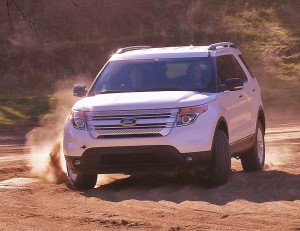
FWD-based Explorer spewed sand from front wheels in introduction test. Bright or body-color grille optional.
Explorer originated on the Ranger pickup platform, long before car-based crossovers moved in and took over. Car-based crossovers handle better and can get better fuel economy than heavier and less-sophisticated truck-based SUVs, so the Explorer leaves behind its aging platform for a new unibody design that is lighter, stronger and more compact, and swaps its rear-drive, or rear-to-all-wheel-drive layout for a front-wheel-drive to AWD plan. Its previous V8 has been replaced by Ford’s high-tech V6, as well.
Ford recently sold Volvo, but not before assimilating the solid Volvo S80/XC-90 platform to house the new Taurus sedan, and a revised version of that platform is under the new Explorer. Fittingly, the Explorer abandons its traditional squarish appearance in favor of a Taurus-influenced look, and a far more agreeable car-like ride and agility. It still meets all-wheel-drive demands, but it gets its torque from a basic front-drive system to AWD. It also can carry seven occupants in its three-row seating, carried in an interior designed after benchmarking industry pace-setter Audi, and boasting better interior quiet than the Honda Pilot and Toyota Highlander — two prime competitors.
Driving the new Explorer through various chores at its California introduction, we ran through deep sand, on fairly challenging off-road excursions, and on winding mountain highways. A few weeks later, I got the chance to test a new Explorer for a week in this memorable Minnesota winter, battling icy highways, a 16-inch blizzard, and some extreme cold. The Explorer handled everything easily, and I definitely appreciated the new console switch setting for driving in snow.
If the market continues to turn away from the largest SUVs it might be foreseeable for Ford’s huge Expedition to yield its customers to the new Explorer, which not only has gained interior room but has trailer-sway control and a rear-vision camera that wide-angle-zooms for aligning a trailer hitch. It even adds park-assist, an amazing system that will actually parallel park itself without touching the steering wheel. In addition, capability as an off-roader includes 8-inch ground clearance and the addition of its Terrain Management System, a console setting switch similar to the new Grand Cherokee. Both are patterned after Land Rover/Range Rover’s familiar and industry-standard all-terrain switchgear.
In the Explorer, the device eliminates the usual transfer case with complete electronic command, on or off the road. As project engineer Don Ufford puts it: “The Explorer retains capability on any road, anytime, anywhere.”
When in 2-wheel drive, the Explorer’s front wheels do the pulling. But when the weather, road conditions, or spirit of adventure call for 4-wheel drive, a flick of the switch lets you click away from Normal and into Snow, Sand, or Mud/Ruts. On-roaders will pretty much stick with either Normal or Snow.
“It’s simple to use,” Ufford explained. “In Normal, if the system detects a difference in traction, it can transfer torque from front to rear. It can send 100 percent of the power to the rear. In Mud, you have quicker 4-wheel-drive response and it holds gears longer. It also shuts off the traction control so you can spin the tires for whatever traction is available, and also to clean the mud from the tread. In Sand setting, you can spin the wheels more aggressively because sand is worse for bogging down. It holds the gear longer and reacts quicker and the traction control can work left to left or right to right. In Snow, the system is less aggressive, starting in a higher gear and shifting sooner to give you less wheelspin.”
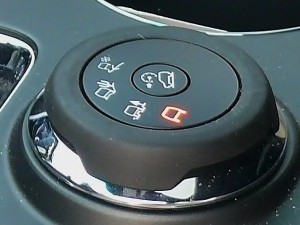
Console control can tailor Explorer drivetrain for snow, sand, mud or normal driving; pushing center button engages hill-descent control.
Ford has replaced the 4.6-liter V8 in the Explorer with its highly-efficient 3.5-liter V6, which boasts 290 horsepower, or 2 horses more than the departed V8, and enough power to haul a 5,000-pound trailer. The dual-overhead-camshaft 3.5 also shows a 32 percent improvement in fuel-efficiency, at an estimated 25 miles per gallon highway. Joining it in a few months will be a turbocharged EcoBoost 2-liter 4-cylinder, which will have 237 horsepower, 250 foot-pounds of torque, and even better fuel economy.
The same 3.5 and 2.0 engines also power the redesigned Edge, which is shorter, has two rows of seats, and is therefore lighter and more agile, and, potentially more popular in Ford’s own market research. “We showed people the new Explorer along with some of its top competitors, and people liked the Explorer,” said Amy Marentic, marketing manager for the Explorer. “Then we showed them the Edge. After really, really liking the Explorer, the majority went on to prefer the 2010 Edge over the 2011 Explorer.”
The Edge, also redesigned for 2011, may in fact prove to be the biggest competitor for the new Explorer, although Ford executives undoubtedly won’t mind at all if the final consumer choice comes down to either one. Ford gambled that the Explorer, with its third-row seating, would still be a major player as a larger alternative. “Customers have evolved, but SUVs haven’t, until now,” added Marentic. Evidence that the Explorer has evolved to catch up with their customers was offered by the Truck of the Year jury, which presented the Explorer the 2011 award, ahead of the Jeep Grand Cherokee and everything else — including the new and impressive Edge.
Several Explorers we drove at the California introduction were surprisingly easy to handle on winding mountain roads, obviously the benefit of the new and tighter unibody structure, wider and with lower center of gravity, and fully independent suspension. It also has Advance Trac and Roll Stability Control, which senses the risk of a rollover and uses electronic braking to straighten out, and also the new Curve Control, which judges steering and yaw rate and can reduce speed by up to 10 miles per hour on the inside wheel to assure that you can make it around the curve you’re approaching.
Radar-based crash avoidance can detect an imminent collision and provides audible and visible warning and fully charges the brake system. If the driver lifts off the gas in such circumstances, it activates what’s called “driver-initiated auto-braking.” Radar also works the adaptive cruise control to maintain an interval with the car ahead, and it functions off the rear corners for blind-spot alert that work s in parking lots as effectively as on the freeway.
s in parking lots as effectively as on the freeway.
The Edge was the most-connectible vehicle when it was introduced, and the Explorer gets all of the same tricks, including the SYNC system for voice-activated control over navigation, audio, heat and air temperature and fan speed. Ford has partnered with Microsoft for the SYNC basics, with Sony for the audio system with its unique high-definition capability, and with TeleNav for an outstanding navigation system, which is satellite based and therefore is constantly updated, and is the same system available as an iPhone “app.”
It’s not fool-proof, although it is constantly evolving. For example, I’ve been able to confound Telenav public relations manager Mark Burfeind — who grew up playing hockey in Wayzata — by asking him to let his system locate the nearest UPS outlet. I had tried to get the system to find or even recognize the Duluth, Mn., UPS outlet, which notified me it had a package in my name. The Edge’s SYNC TeleNav readily found FedEx, but even when I spelled out “United Parcel Service” it assured me I must have meant United Methodist Church, or one of dozens of other places starting with the word United, and it refused to acknowledge that UPS or United Parcel Service existed. I’ve tormented Burfeind ever since, wherever Ford introduces a new vehicle, by suggesting he tries to find the nearest UPS outlet. Otherwise, after learning to communicate with SYNC, it will find a song from your iPod, a phone listing from your iPhone, or a restaurant, movie, park, or gas station by either general or precise request. All the elements can be connected by a thumb click on the steering wheel switch, then using voice commands, all without taking your eyes off the road or your hands off the steering wheel.
While such devices improve general safety, the Explorer is loaded with structural safety. Trinity architecture includes twice as much high-strength steel in its construction, with longitudinal, vertical and lateral reinforcements, and the strongest Boron steel in certain stressed areas, such as the entire B pillar between the front and rear doors on both sides. High-strength steel is stronger even when using thinner-gauge steel, which helps make the Explorer lighter and stronger at the same time. Aluminum hoods, and front axle joints adds to making the new and larger Explorer 100 pounds lighter than its predecessor, even while measuring 3 inches longer, and 5 inches wider. Its wheelbase is actually an inch shorter.
Supplemental safety comes from airbags that surround occupants, and include rear seatbelts with inflatable chest-area straps. Side curtain airbags run front to rear and stay inflated in case of a rollover.
The Explorer also has hill-descent control, adapted from the Raptor pickup, for creeping down steep grades off-road. It works amazingly well to let you pick your way down rugged terrain without touching gas or brakes. It’s important for all wheels to keep turning in order to maintain control regardless of how slow you’re moving, because stepping on the brakes could cause your vehicle to skid out of control. “Push the button, and hill-descent control is engaged,” said Ufford. “You can step on the brake or gas to adjust speed, otherwise it holds your speed and lets the wheels keep turning.”
That off-road capability gives the Explorer a distinct difference from the rest of Ford’s crossovers.
“The Explorer is 5 inches shorter than the Flex and more maneuverable, while being 2.5 to 3 inches wider,” said Jim Holland, the Explorer’s chassis engineer. “And there is a distinctly different market for the Explorer and the Edge. Edge people want two rows of seats and the vehicle dynamics that size allows. The Explorer, however, is a true SUV, while the Edge is not. The Edge is something you take to the airport when you and your family are going on vacation; the Explorer is what you take on vacation.”
Comments
Tell me what you're thinking...
and oh, if you want a pic to show with your comment, go get a gravatar!


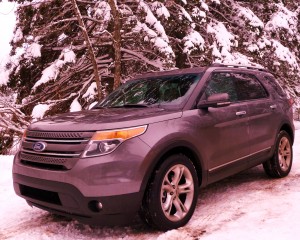
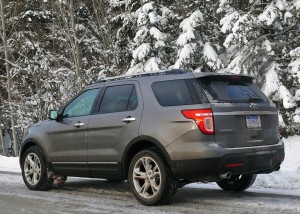
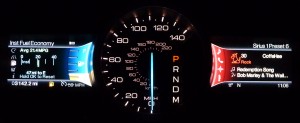
 John Gilbert is a lifetime Minnesotan and career journalist, specializing in cars and sports during and since spending 30 years at the Minneapolis Tribune, now the Star Tribune. More recently, he has continued translating the high-tech world of autos and sharing his passionate insights as a freelance writer/photographer/broadcaster. A member of the prestigious North American Car and Truck of the Year jury since 1993. John can be heard Monday-Friday from 9-11am on 610 KDAL(www.kdal610.com) on the "John Gilbert Show," and writes a column in the Duluth Reader.
John Gilbert is a lifetime Minnesotan and career journalist, specializing in cars and sports during and since spending 30 years at the Minneapolis Tribune, now the Star Tribune. More recently, he has continued translating the high-tech world of autos and sharing his passionate insights as a freelance writer/photographer/broadcaster. A member of the prestigious North American Car and Truck of the Year jury since 1993. John can be heard Monday-Friday from 9-11am on 610 KDAL(www.kdal610.com) on the "John Gilbert Show," and writes a column in the Duluth Reader.